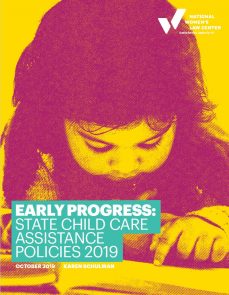Abortion rights, women of color, and LGBTQIA+ people are under attack. Pledge to join us in fighting for gender justice.
Early Progress: State Child Care Assistance Policies 2019
Child care is crucial for the well-being of parents, children, and our nation. It enables parents to work and support their families. It gives children a safe, nurturing environment to learn and develop skills they need to succeed in school and in life. And, by strengthening the current and future workforce, it boosts our nation’s economy. Yet many families, particularly low-income families, struggle with the high cost of child care. These costs can strain families’ budgets, force parents to use lower-cost care even if they would prefer other options for their children, or prevent parents from working because they cannot afford care. Child care assistance can enable families to overcome these challenges by helping families pay for child care.
Given the importance of child care assistance to families, it is essential for states to have strong child care assistance policies. Under the Child Care and Development Block Grant (CCDBG), the major federal child care assistance program, states have flexibility to set policies within federal parameters. This report examines states’ policies in five key areas—income eligibility limits to qualify for child care assistance, waiting lists for child care assistance, copayments required of parents receiving child care assistance, payment rates for child care providers serving families receiving child care assistance, and eligibility for child care assistance for parents searching for a job.
Between February 2018 and February 2019, states were able to make meaningful progress in their key child care assistance policies due to a historic increase of $2.37 billion approved by Congress in March 2018. The total number of children on waiting lists for child care assistance decreased by 55 percent. Over half of the states increased payment rates for child care providers serving families receiving assistance, with an average increase of over $100 per month per child. Yet, significant gaps remain in child care funding and policies. Total funding for child care in FY 2019—even after the increase—remained nearly $1 billion short of the total funding level in FY 2001 after adjusting for inflation. As a result of inadequate funding, nearly one-third of states still have waiting lists or frozen intake for assistance, only a handful of states set payment rates at federally recommended levels, and other state policies make it difficult for families to get the help they need. Significant additional federal and state investments will be necessary to address these remaining gaps.
Key State Child Care Assistance Policies in 2019, State by State
In February 2019, a family with an income above 150 percent of poverty ($31,995 a year for a family of three) could not qualify for child care assistance in 13 states. Fifteen states placed families applying for child care assistance on waiting lists or had frozen intake (turned away eligible families without adding their names to a waiting list). And in all but four states, payment rates for child care providers serving families receiving child care assistance were below recommended levels.
Click on a state below to see information about its policies in a few key areas, including:
-
- The income limit up to which a family of three can qualify for child care assistance, as an annual dollar amount and as a percentage of the 2019 federal poverty level ($21,330 a year for a family of three).
- The number of children or families on the waiting list for child care assistance (if the state places eligible children and families who apply for assistance on a waiting list).
- The provider payment rate for center care for a one-year-old whose family is receiving child care assistance, in the state’s most populous city/county/region, and a comparison of that rate to the federally recommended level (the 75th percentile of current market rates) for that type of care.
Notes:
The income limits shown in the map represent the maximum income families can have when they apply for child care assistance; some states allow families, once receiving assistance, to continue receiving assistance up to a higher income level than that initial limit. Also note that in a few states, the income limit varies by locality; for those states, the range of income limits is shown.
The monthly rates shown in the map were calculated from hourly, daily, and weekly rates assuming the child was in care 9 hours a day, 5 days a week, 4.33 weeks a month. For states that pay higher rates for higher-quality care, the most common rate level (the level representing the greatest number of providers) for each state is used. Payment rates in the map are compared to the federally recommended level, which is the 75th percentile of current market rates—the rate designed to allow families access to 75 percent of providers in their community.
A number of states have had changes in their income limits, waiting lists, and/or payment rates since February 2019.
See Early Progress: State Child Care Assistance Policies 2019, Tables and Tables Notes for more details about each state’s policies in February 2019 and changes since February 2019.

